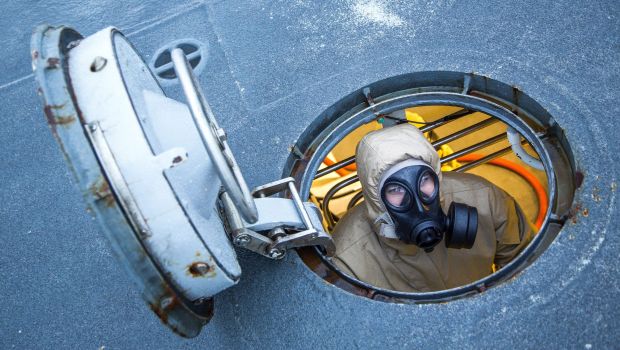
A crew member of the Norwegian frigate KNM ‘Helge Ingstad’ completing a gas safety practice onboard the vessel at an undisclosed location in the Mediterranean Sea, 30 December 2013. (EPA/LARS MAGNE HOVTUN / NORWEGIAN ARMED FORCES / HANDOUT)
Sigrid Kaag, head of the joint mission of the United Nations and Organisation for the Prohibition of Chemical Weapons (OPCW), said 54 percent of the toxins had been removed or eliminated.
The process, which President Bashar Al-Assad’s government agreed to after a chemical attack killed hundreds of people around Damascus last year, is months behind schedule but Kaag said the new momentum “would allow for timely completion”.
“The joint mission welcomes the momentum attained and encourages the Syrian Arab Republic to sustain the current pace,” Kaag said in a statement.
Syria has already missed a February 5 deadline to hand over or destroy all 1,300 tonnes of chemical agents which it declared last year.
Last week it missed a deadline to destroy a dozen production and storage facilities.
Syrian authorities, battling a three-year uprising and insurgency against Assad’s rule, blame security problems for the delays in bringing the chemicals through contested territory to the Mediterranean port of Latakia.
Last month Syria said there were two attempted attacks on convoys transporting chemical weapons, and two storage sites remain inaccessible due to the civil war which has killed 140,000 people and ravaged whole districts of Syrian cities.
Five rockets were fired towards the Latakia port area earlier this month, with one landing near to where the international chemical team was staying, sources said on Tuesday.
Assad agreed with the United States and Russia to dispose of the chemical weapons—an arsenal which Damascus had never formally acknowledged—after the August chemical attacks in the Ghouta and Mouadamiya suburbs around the Syrian capital.
Washington and its Western allies blamed Assad’s forces for the world’s worst chemical attack in a quarter-century, and nearly launched military strikes in response. Damascus said anti-Assad rebels were responsible.
Lengthy delays at the start of the year have left Syria several months behind schedule and it risks missing a June 30 deadline for the chemicals to be destroyed. It has proposed an April 27 target to complete the removal of the chemicals.
The OPCW said another consignment of ‘Priority 1’ chemicals, considered the most dangerous, was delivered to Latakia on Thursday—the 11th to be transported out of Syria.
More than one third of the Priority 1 chemicals have now left the country, it said, including all of Syria’s declared mustard gas stocks.
Mustard gas is the most dangerous to transport because it is stored in the same form that is deployed in warfare. Components of other binary agents such as sarin are kept separately and only mixed when they are loaded into weapons, making them safer to store and move around.
Most of the Priority 1 chemicals will be neutralized at sea on a US vessel, while the rest will be handled at a British facility in Ellesmere Port, northwest England. The less toxic Priority 2 chemicals will be destroyed in the United States and Finland.
The UN-OPCW statement said experts inside Syria were forming a plan for the destruction of the chemical weapons storage sites.
